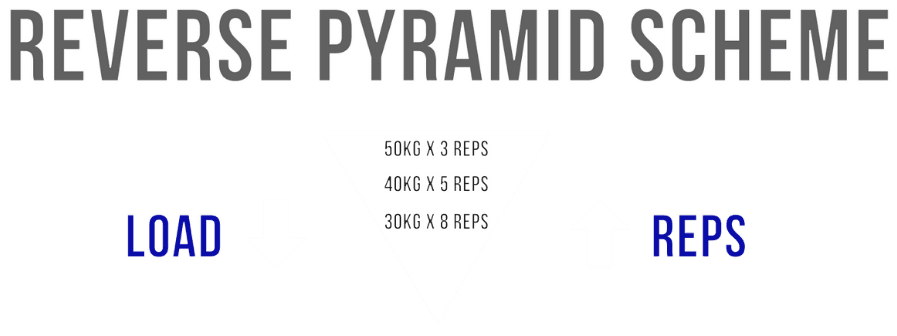You are currently exploring the Fundamentals Library, which is designed to provide a basic overview of the topics that are covered in other longer articles. This article is a part of the Progression section.
Progression Models
The progression model is a planned increase in objective training demands to maintain relative training demands, with the supposition that progression has occurred.
The supposition that progression has occurred means that our progression model is typically based on a hypothesis. We assume that you will get better at a certain rate. However, this is just an estimate that we make based on the training history and characteristics of an athlete.
We differentiate two distinct progression model types:
- Fixed Progression Models
- Autoregulative Progression Models
In this article, we will focus on fixed progression models. We will discuss the specific methodology behind them and talk about their utility.
Fixed Progression Models
The fixed progression models don’t account for daily fluctuations in performance, but they provide a planned, structured way of increasing the objective workout demands. Before we get to the progression models themselves, we need to understand some basic terminology I created that can help us categorize different aspects of the models:
Pattern refers to the general trajectory of the progression, the most common ones are:
- Linear
- Step
- Wave*
Linear pattern means increasing a certain variable by some amount every single training session. Step pattern means that we increase, then next session (or a couple of sessions) we leave the variable at the same level to increase it again afterwards. Finally, the wave pattern means we increase the variable to some extent, to then lower it down and then raise it again above the previous magnitude. It could be argued that the wave pattern is not really congruent with the progression model idea, as if that's the case it assumes we get worse periodically.



Scheme refers to the structure of the battery of sets in terms of repetition number:
- Straight Sets
- Reverse Pyramid
- Pyramid*
Straight sets refer to the scheme where each set is done with the same number of reps (for example 5x5). Reverse pyramid means reps increase along with the sets as load decreases (for example 5/3/1). Pyramid approach is the opposite, the repetitions go down across the set battery and load increases (for example 15/10/5). Pyramid method is rarely used in strength training as we can suspect it is not as effective in that regard.


Strategy refers to the approach of increasing the demands:
- Set Battery
- Individual Set
- Repetition Number
Set battery strategy refers to increasing a certain variable across all sets when a certain goal is set across them (for example increasing from 3x5 to 3x6). Individual set strategy separates the sets and allows for looking independently at each set as separate in terms of progression. Finally, the repetition number strategy refers to treating all sets as the pool of repetitions or seconds and increasing them in a battery, but without a constraint over individual set results. For example, if the goal is 15 reps, then 8/2/5 is a successful battery that signals we can apply progression.
Once we have the understanding of the processes above. There are three fixed progression models that can be applied:
- Load Progression
- Double Progression
- Volume Progression*
We won’t discuss volume progression in this article as I think it is not a method designed with strength training in mind, and it could be seen more as a periodisation model rather than progression model. More on that in some other article.
Fixed Load Progression
Fixed load progression is one of the most straightforward concepts. The basic idea of it is that you gradually increase the amount of resistance used in an exercise over time while keeping other variables the same in all the workouts. Load Progression can be implemented using several different patterns, schemes and strategies.

The first and most common pattern is Linear Progression. In linear progression, the load is increased by a fixed amount every single session. For example, if you're performing squats, you might add 2.5 kg to the bar each subsequent training session:
- Session 1 - 50 KG x 3x5
- Session 2 - 52.5 KG x 3x5
- Session 3 - 55 KG x 3x5
Another pattern is the Step Progression. In step progression, the load is increased at specific intervals, but instead of increasing the weight every session, you maintain the same load for several sessions before increasing it again. For example, you might increase the weight every third or fourth session, giving your body time to adapt to the current load before moving to the next level:
- Session 1 - 50 KG x 3x5
- Session 2 - 50 KG x 3x5
- Session 3 - 52.5 KG x 3x5
- Session 4 - 52.5 KG x 3x5
- Session 5 - 55 KG x 3x5
- Session 6 - 55 KG x 3x5
The final pattern is the Wave “Progression”. Here, the load is increased and then slightly decreased in a cyclic manner before increasing again. For example, you might perform sets at 35KG, then increase to 37.5 and 40 in the following sets, before dropping back down and repeating the process, this time starting from 37.5KG:
- Session 1 - 50 KG x 3x5
- Session 2 - 52.5 KG x 3x5
- Session 3 - 55 KG x 3x5
- Session 4 - 52.5 KG x 3x5
- Session 5 - 55 KG x 3x5
- Session 6 - 57.5 KG x 3x5
Within these load progression patterns, there are also different schemes you can use to structure your sets and reps.
Straight Sets are one of the most commonly used schemes, where you perform the same number of repetitions across all sets. The most popular are 3 sets of 10 reps, 5 sets of 5 reps (5x5), 3 sets of 5 reps (3x5), and 3 sets of 3 reps, but obviously, any configuration here is available.
Another popular scheme is Reverse Pyramid Training. In RPT, you start with your heaviest set with the most load, and then reduce the load* for subsequent sets. There are different variations of RPT, such as performing a set of standard sets with a moderate weight after the top set, followed by a back-off set with an even lighter load.
In both of these schemes, we can use different strategies for adding load. The ones recommended for this model are set battery strategy - which in this context will mean adding load to each set of the exercise:
- Session 1 - 50 KG x 3x5
- Session 2 - 52.5 KG x 3x5
- Session 3 - 55 KG x 3x5
or individual set strategy - meaning we will add weight independently, set by set:
- Session 1 - 50 KG x 5 / 50 KG x 5 / 50 KG x 5
- Session 2 - 52.5 KG x 5 / 52.5 KG x 5 / 50 KG x 5
- Session 3 - 55 KG x 5 / 52.5 KG x 5 / 52.5 KG x 5
- Session 4 - 55 KG x 5 / 55 KG x 5 / 55 KG x 5
Fixed Load Progression - Recommendations
When it comes to load increments, the amount by which you increase the load can vary depending on your experience level and the exercise you're performing.
The load can be increased based on a percentage, a fixed number of kilograms, or by making the variation of the exercise more difficult, which would typically be required in the case of calisthenics.
For very advanced individuals, we can use a microload strategy - very small load increments (such as 0.25-1KG).
Fixed Load Progression - Which Exercises?
Unfortunately, due to its dependence on a certain degree of sensitivity in load selection, this method is strictly reserved for exercises performed with external resistance, ideally one that can be easily tracked and manipulated in an incremental manner.
Exercises that fit this description include both barbell exercises and externally loaded calisthenics exercises. The caveat is that if you want an extra level of sophistication, in the latter you can actually track your body weight and adjust the external weight so that your daily body weight also dynamically contributes to the load.
Static weight exercises (which are performed not so often) can be technically trained using this method, and if you happen to do it in an exercise that is well trackable, just use seconds instead of repetitions.
Fixed Double Progression
Let’s explore the second system that can be implemented, which can be called Fixed Double Progression. Double progression will have a lot of similarities to the already discussed load progression.
The word “double” simply refers to the fact that the process of increasing load is broken down to two separate stages and happens on two tracks. We first increase the repetitions or seconds, and when we achieve a given goal number of repetitions, we increase the load.

The basic idea is to plan the increase in the number of repetitions or the duration of the hold in an exercise, and once a certain target is reached, the load is increased and the process starts again, this time with a new load. Double progression, just like load progression, can be applied in different patterns, schemes and strategies.
One approach is to progress with a set battery, where all sets are put into one basket, and the load is increased in all sets once each one of them achieves a certain goal:
- Session 1 - 50 KG x 4/4/4
- Session 2 - 50 KG x 5/5/5
- Session 3 - 50 KG x 6/6/6
- Session 4 - 55 KG x 4/4/4
On the other hand, we can also progress on an individual set basis, where each set progresses independently:
- Session 1 - 50 KG x 4/4/4
- Session 2 - 50 KG x 5/5/4
- Session 3 - 50 KG x 5/5/5
- Session 4 - 50 KG x 6/5/5
- Session 5 - 50 KG x 6/6/6
- Session 6 - 55 KG x 4/4/4
In some cases, what can be used is the repetitions number strategy. I would advise using it in case of exercises with high coordination demand and technical variability between repetitions. The example below illustrates the partial handstand push up scenario, where the goal is 8 reps per battery and we try to increase 1 repetition per set battery:
- Session 1 - 1/3 ROM x 3/2/1
- Session 2 - 1/3 ROM x 4/1/2
- Session 3 - 1/3 ROM x 2/3/3
- Session 4 - 2/3 ROM
So, there is a certain rep goal for the session and once it has been achieved, the load increases. But the way this goal is achieved doesn’t make any difference.
Fixed Double Progression - Recommendations
The general rule is that the larger the range of repetitions increases, the more load we can add once the upper threshold is achieved.
Sometimes, the range must be extended, due to problems with incremental load selection, as in many calisthenics specific cases. Adding repetitions or seconds should then happen linearly or in a step fashion.
Fixed Double Progression - Which Exercises?
This method gives calisthenics athletes and coaches a lot of room for a strict and well planned progression, which was impossible in the case of load progression.
It can be applied to all types of exercises. Apart from those mentioned in the previous method, it will work well with exercises using dumbbells, kettlebells or bands, which provide a less incremental system of progression. Therefore, increasing the number of reps could be a nice gap in between, for example, using a different dumbbell that might be 10% heavier than the previous one.
Another obvious group that will benefit from this is bodyweight exercises, where the load is simply difficult to define objectively.



